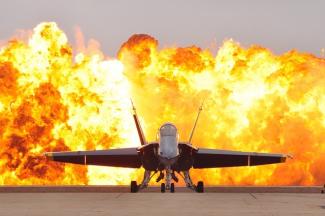Hannah Huibregtsen, Leiden University, highlights the problems of under-reporting of military greenhouse gas emissions, as huge military spending targets are being agreed.
Responsible Science blog, 24 June 2025
As Europe ramps up military spending in response to rising geopolitical tensions, climate change is slipping further down the political agenda. In particular, the effect of this militarisation on global greenhouse gas (GHG) emissions remains severely overlooked in current debates. Instead, the military is often granted exemptions on the grounds of ‘national security’ with expansion of the armed forces viewed as taking priority over climate concerns. Yet by ignoring this nexus, Europe’s militarisation is contributing to the very security threats it seeks to reduce.
According to estimates by Scientists for Global Responsibility and the Conflict and Environment Observatory (CEOBS), in 2019, military activities were responsible for an estimated 5.5% of global GHG emissions. With rising spending targets, these emissions are expected to grow markedly. Indeed, as this article goes to press, NATO is set to agree national targets for military spending of 3.5% of GDP, plus an additional 1.5% on related items such as cyber security, amounting to a total of 5% of GDP.
Despite this significant contribution of the military to global GHG emissions, under current international frameworks, the Paris Agreement and the EU Green Deal, reporting of military emissions remains voluntary and, in many cases, incomplete or absent. This has created a ‘military emissions gap’, as armed forces operate in a ‘grey zone’ outside of climate accountability.
My master’s thesis [1] explored the implications of this military emissions gap across the 23 EU-NATO countries for the EU Green Deal. First, it examined a military emissions ‘reporting gap’ and second, it estimated how military emissions for EU-NATO Member States will rise under the ReArm Europe Plan. To carry out this analysis, I used a slightly modified version of the military emissions mapping methodology developed by Tipping Point North South (TPNS) and the Transnational Institute (TNI), together with the NATO Defence Expenditure Dataset.
Military emissions: the reporting gap
At present, nations – including those from the EU – are not required to systematically report military emissions under the United Nations Framework Convention on Climate Change (UNFCCC). Direct military emissions can be included voluntarily in certain categories, but these categories are vague and inconsistently used. In addition, civilian and military data can be mixed without being broken down. Furthermore, to evaluate the total military carbon footprint, additional analysis is needed.
In their reports to the UNFCCC, the 23 EU-NATO countries collectively reported a total of 6.9 million tonnes of carbon dioxide equivalent (MtCO₂e) of military emissions under relevant categories for 2021. However, my research estimated the total military carbon footprint for 2021 at approximately 39 MtCO₂e, more than five times the size.
It is important to note that the UNFCCC reporting framework requires the reporting of direct emissions (known as 'scope 1' emissions) to eliminate double-counting. However, policy decisions – especially related to spending priorities – require consideration of the total carbon footprint. For military emissions, this includes direct emissions from fuel use in air, sea and land craft and installations (‘scope 1’), and indirect emissions from purchased energy (‘scope 2’) and supply chains, including equipment production (‘scope 3’). My estimates, based on aggregate NATO spending data, include all three scopes necessary to estimate the total military carbon footprint.
Projected increases under ReArm Europe
In response to the current geopolitical tensions, this military emissions gap will become an even larger obstacle to climate governance. The EU envisions an additional €800 billion of military spending between 2025 and 2028 through its ReArm Europe Plan, an increase in annual military expenditure of over 50% compared to 2024.
Based on conservative projections, I estimate that this could increase EU-NATO’s military carbon footprint to approximately 95 MtCO₂e, a rise of over 140% compared to 2021 emissions. This total would be more than the annual national emissions of several medium-sized EU Member States such as Portugal or Croatia.
These projections are consistent with other recent studies:
- A new TPNS-TNI analysis of the rise in military emissions that would be caused by NATO member states meeting the new 3.5% GDP spending target.
- A CEOBS-led study highlighting that rising global military expenditure poses a serious risk to achieving Sustainable Development Goal 13 on climate action.
- A 2025 Nature Communications study estimates that military spending trends could increase global CO₂ emissions by between 1.1% and 2.5% by 2030.
All point to major increases in GHG emissions associated with planned or projected rises in military spending.
Compromising climate action
The evidence points to the ReArm Europe Plan, new NATO spending targets, and other policies like them compromising the goals of the Paris Climate Agreement. However, governments seem to be ignoring this possibility, partly due to an unquestioned priority for military activity and partly due to poor data reporting. European governments are claiming climate leadership, but their policy choices fall far short.
Consequently, I make three recommendations, especially for the EU:
- Mandate transparent reporting of all direct (scope 1) military GHG emissions to the UNFCCC;
- Mandate transparent reporting of all direct and indirect (scopes 1, 2, 3) military GHG emissions through annual reports of defence ministries; and
- Give greater priority to the targets in the Paris Agreement in government decisions about security policies.
Hannah Huibregtsen has just completed her Master's thesis in international relations at Leiden University, Netherlands.
Main reference
[1] Huibregtsen H (2025). The Military Emissions Gap: analysing the implications of militarisation for the EU Green Deal. MA thesis. Faculty of Humanities, Leiden University.
Also see...
Climate change and the military - SGR project web-page
[image credit: USAF]
